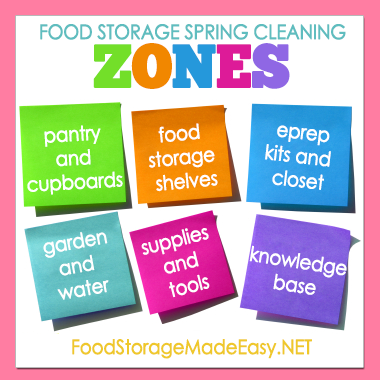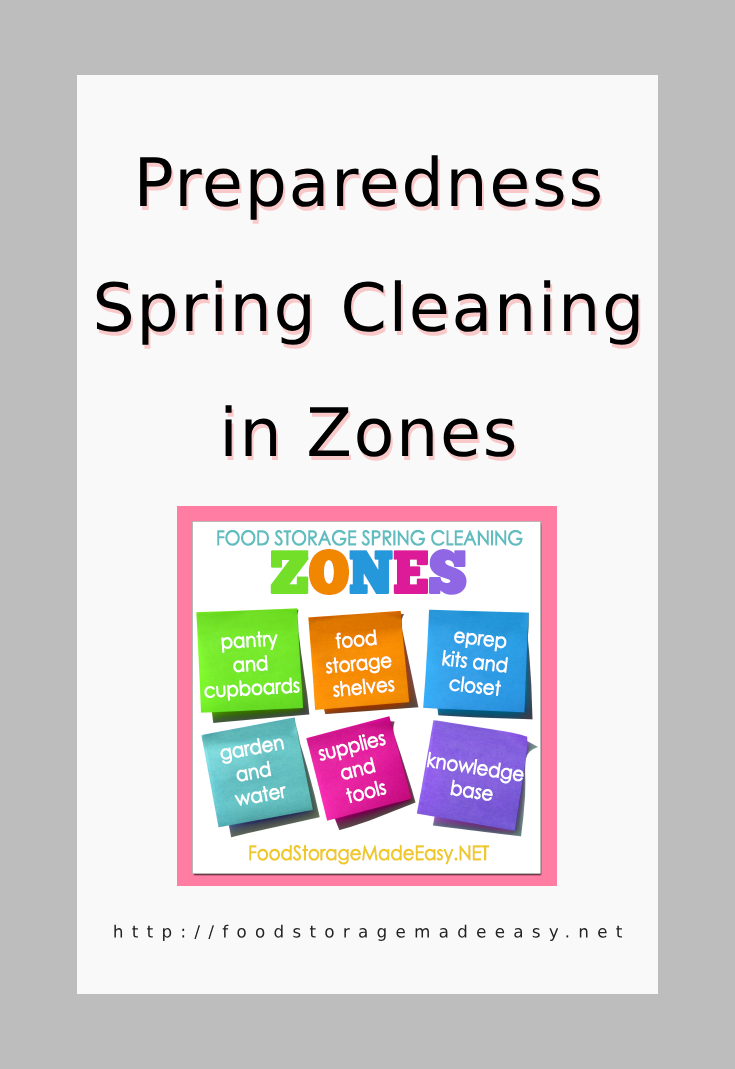Spring is in the air… and with that comes spring cleaning. I admit I buy into the spring cleaning frenzy. I love clearing things out of my house. Recycling, de-cluttering, donating things, and throwing things out makes me happy. Today I wanted to talk about Food Storage and Emergency Preparedness Spring cleaning!
A few Saturdays ago something happened in our schedule that never happens. We had NOTHING scheduled. Well I got giddy with excitement, pulled out some post-it- notes, and started on a rampage. I wrote down every project I wanted done. I got started working through the projects on my post-it-notes one by one. I placed all of them on my fridge and as I completed a task I pulled the note off. I still have a few more post-it-notes to get to, but I feel awesome. These areas weren’t related to my food storage and eprep specifically but the concepts apply.


- Throw away any expired foods
- Donate any foods you aren’t going to end up eating after all
- Move foods you know you should get around to eating to the front
- Make foods you use more frequently more accessible
- Install cansolidator rotating shelves to make rotation easier
- Combine like foods that you may have more than 1 bag open for (pastas, cereals, etc)
- Sweep out the bottom of the floors and wipe shelves down
- Keep smaller containers of grains you use less frequently in your pantry to save space
- Store multiples of the same foods on your food storage shelves if you have a separate area to save space in your pantry
- Check to see if some of your containers are empty and just taking up space
- Create granola or trail mixes with foods you have just a little bit left of
- Clear out old tupperwares with missing lids and old dishes you no longer use
- Go through baking cupboard and consolidate foods and combine like items

- Combine like foods on shelves (fats, grains, fruits, vegetables, legumes etc)
- Date foods with a sharpie so you know when you bought them if they don’t have expiration dates on them
- Move older foods to the front, and newer foods to the back
- Inventory what you have on your shelf for your Three Month Supply and for your Long Term Food Storage
- Make a purchasing plan for what you need
- Assess your non-food items (this one is easy to forget)
- Wipe down any shelves that may need it (dust,spills, dirt)
- Move foods close to expiring to your pantry to encourage and remind you to eat them
- Have your kids help

- Review your 72 hour kits (part 1) (part 2)
- Rotate 72 hour kit foods by using them for a camping trip or snacks
- Swap out clothes for kids that have become too small
- Check batteries in flashlights etc
- Look over our Emergency Prep Guide to see if you are missing anything
- Review your emergency protocols with your family
- Update eprep plan with new phone numbers for family members etc
- Update your evacuation list with any items that may be new or obsolete
- Rotate water in your kits
- Assess and update your Emergency Binder

- Clean out weeds or old plants from garden beds
- Make your 2014 garden plan
- Refill gardens with new compost if needed
- Prune fruit trees and bushes as necessary
- Plant vegetables (check out this guide to when you can plant each type of vegetable specific to your area)
- Rotate water storage by watering your gardens
- Check water filters

- Inventory your fuel supplies
- Make sure your fuel is still good for powerless cooking
- Test your powerless cooking tools to ensure they are in good working order
- Store extra or old dishes cleared out of your kitchen with your supplies instead of buying new ones

- Review basic first aid and CPR procedures
- Review your Food Storage Made Easy Book encyclopedia section for a refresher on what you should be storing / rotating / etc.
- Print recipes you use frequently online so that you have them as hard copies
- Pick a topic you want to learn about and make arrangements to improve your knowledge in that area
Pin This to Save for Later


-Jodi Weiss Schroeder
http://foodstoragemadeeasy.net

